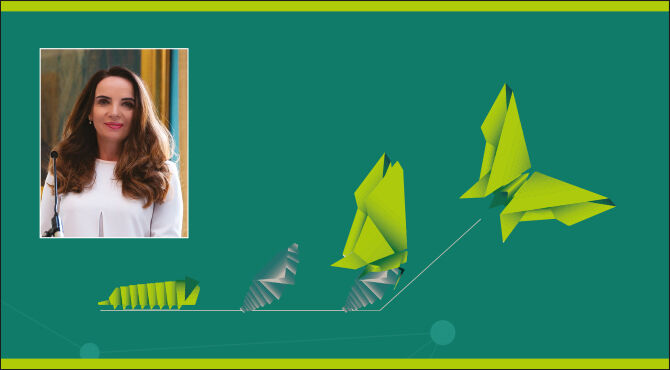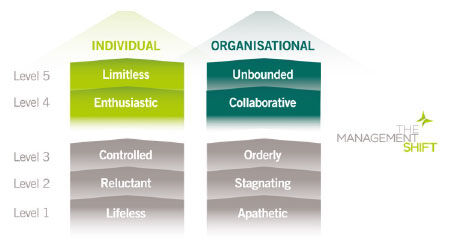It is time to transform management and leadership practices to survive and thrive
Employees are looking for purposeful roles, happy workplaces and trusted leaders. How does your organisation stack up?

Download the brochure for the next transformational programme for international leaders with Professor Vlatka Arianna Hlupic
(898k)
Perhaps you have been affected by this pandemic significantly and you had to let go of some of your key talent. Perhaps you realise that you need to go through transformation, but you do not know how. Or perhaps you know that the management and leadership style used in your organisation is not fit for purpose anymore, but you do not know where to start and how to change it.Now imagine working for an organisation where people are happy, purposeful, fully engaged and go the extra mile for your customer. Imagine working for an employer where everybody is purposeful and intent on making the world a better place by working for your organisation. Imagine your workplace is engaging, innovative, highly productive, and profitable.This article shows how you can reinvent your management and leadership practices, and not just survive but also thrive today and tomorrow. We need this transformation because even before the global pandemic started, we could see that there were many problems in a lot of organisations. For example, only about 13% of employees were fully engaged at work before the pandemic. Only about 25% of people are passionate about their work. Just 20% of employees trust that their leaders will tell the truth when confronted with a difficult issue. And in the last 50 years, corporate life expectancy and performance have declined by 75%. Different surveys paint a similar picture – with the vast majority of the global workforce dissatisfied with their work.Various studies have looked into what employees need from leaders right now and concluded they need clarity, purpose and clear goals, because clarity will contribute to resilience. They need to be able to trust their leaders and trust will lead to better communication. Employees also need psychological safety, so they can express their views in a safe way, knowing that their voice will be heard and then any reasonable action will be taken as needed. People want leaders to give them some sense of autonomy and how they achieve goals, and they understand they need to be accountable for the results. And finally, they want compassion. They want to be led by compassionate leaders who will support their wellbeing.
Workplace renewal
Many organisations have to be very innovative now as they move out of the pandemic to hybrid workplaces. They must reinvent, create new workplaces, new opportunities, new markets, new products and new services. Innovation and creativity are crucial moving forward. Leaders also need to figure out what kind of culture they need right now for new hybrid workplaces, and how to attract and keep talent. For example, a recent survey by Microsoft in Sweden found that more than 40% of employees are seriously thinking about leaving their employer when the lockdown finishes. So how can we create cultures and working conditions so that both leaders and employees get what they need and want, right now?In order to do that, we need a new type of management and leadership. We need to move away from traditional pyramids with hierarchical command and control, standardisation, specialisation, strict rules and regulations, centralised command and decision making. This worked well in the first industrial revolution where productivity and efficiency were the key, but it is very detrimental for performance in modern organisations, which are largely comprised of knowledge workers. We know knowledge workers need to be treated as associates, not as subordinates.Figure 1: 5 levels of The Management Shift framework

I have researched many organisations operating at Levels 4/5 (more details are available in my book “Humane Capital”) and here are a few examples.
The City of Glasgow College - inspirers
In the City of Glasgow College, the senior leadership team went through The Management Shift Senior Leadership Development Programme, which lasted four months and has brought several benefits for the College, including winning more awards and better grades for students.At the heart of transformation of the City of Glasgow was a transformation of their leadership approach that was previously rooted in the impulse to control everything. The difference is not just a different set of skills of competencies, but a different mindset and different philosophy. They embraced a leadership that prepared them to be agile in uncertainty. In the college, they used every single space inside and outside classrooms as a learning space, fostering peer learning and social learning as students can also learn from each other. Educators saw themselves as being inspirers rather than lecturers and the teaching staff became more open and communicative embracing social media and continuous communication with students.Their conscious move to a level 4 culture was concurrent with the move from eleven old campuses to one modern campus. They formed affinity groups to establish real human connectivity, to be empathetic and mindful. This ensured that in decision making and in the creation of the system structure and plans they put in place, the human connection had to be maintained. The Management Shift Programme provided a structured vehicle to achieve their objectives and to ensure that they retained and developed their talent.As a result of all this development they have established stronger, more trusting relationships, which have led to the ongoing success of this educational institution.Salesforce - innovation & values
The next example is Salesforce, one of the largest cloud computing firms in California. Salesforce was founded upon transparency of goals, shared purpose, absence of micromanagement, and minimisation of bureaucracy. These founding principles are very much aligned with level 4 leadership style and organisational culture.It is interesting to explore in more detail what practices Salesforce has adopted. One of the key principles around Salesforce’s approach to their culture and leadership was, for example, collecting ideas from all employees, which is very important.For example, Salesforce has an internal social media platform called Chatter, which is used by the firm’s 18,000 employees. If anyone has an idea, they can post it on Chatter and seek offers of help with innovative ideas. The platform is also used for surveys, questionnaires, and innovation in general.They are also aligning individual and organisational values and purpose. Their values are articulated by the acronym v2mom, which was created by its founder Mark Bienoff. It stands for vision, value, methods, obstacles, and measures. Vision helped them define what they wanted to do and set out the principles and beliefs that guide behaviour. The values established what was important.Some of the questions around that are “How do you want to change the world? And what do you want to do? What methods obstacles and challenges are you going to meet in your attempt to create that vision? Do you need the organisation to help you meet your goal?If so, how do we invest in that and how do we make that happen? Everybody in the company is aligned around these questions.They also have their 1 1 1 Programme where they give 1% percent of their equity, 1% of all employees’ time and 1% of their product back to non-profit organisations. Employees get paid time-off to contribute to the society. A few years ago, they handed about $75 million to non-profit organisations.Salesforce believe that those who don’t move from level 3 to level 4 are going to be threatened by companies that do. Exceptionally talented people don’t want to work for level 3 organisations. They want to work at level 4 and level 5.
Handelsbanken - leadership culture
Handlesbanken was created in its present form in 1960. It has held to the principles of co-operation rather than relying on excessive hierarchy and they went through some profound transformation in the late 1960s where a new management model was introduced and retained until today. Some of the key principles include striving to do better than their peers by removing absolute goals and cutting costs. They introduced one single financial goal which was to have higher return in equity than the average of their competitors. It was all about doing better than competitors.They have been using these principles and they haven’t done any budgeting over 40 years. They do not believe in fixed planning, and they believe that in order to achieve their goals, they needed to excel in two areas. One area was to have the highest level of customer satisfaction. The other area was to have lower operating costs. Another strategy is to empower people who are best suited to understand the needs of customers.This means that their pyramid is flat. They got rid of layers and layers of middlemen and empowered local branch managers to make key decisions to serve their customers.The main belief is that if you actively encourage people to take responsibility, those people will not run off and take silly decisions.Instead, they will become even more prudent and even more careful when it comes to ensuring that the correct decisions are made. The whole purpose of the Handlesbanken’s Head Office is to support local branches. It does not tell branches what to do and discipline is maintained. This is an example of Level 4 leadership/culture.Since the bank introduced these ways of working, it has achieved a higher return on equity every year for over 40 years. And it has consistently scored highly in independent customer satisfaction surveys. They even went through the international banking crisis in 2008 without needing support from stakeholders or the state. The other notable principle they used was to move away from the bonus culture towards a profit-share model. They do not pay bonuses, which is consistent with their approach of avoiding sales targets and short-term goals. There is a strong emphasis on recruiting the best people and pay is competitive.The profit-sharing system, which was introduced in the early 70s, is called Octagon. Profit accrued from the average return on equity for the industry goes back to the staff in the form of a foundation. That profit is then divided by the number of employees, which is then converted into a fund that invests mainly in Handelsbanken shares. These profits cannot be withdrawn by employees until they reach the age of 60 even if they leave the bank. The profit-sharing scheme encourages long term objectives and the focus on customer satisfaction, and it also encourages cooperation.The key is to break away from short-termism and short-term targets. With these principles, Handlesbanken has been very successful for decades.These case study examples illustrate how three organisations working in very different industries, but using similar principles of level 4/5 leadership and organisational culture can achieve amazing results and outperform their competitors.Next steps
We will be running transformational leadership programmes for the Relocate and Think Global People community in October and November. I will be teaching the key principles of The Management Shift supported by individual and organisational assessments that can be applied in your own organisation to improve innovation, performance, engagement, and profit or to make a bigger difference for your learners and society at large. I look forward to seeing many of you on these programmes.Find out more at The Management Shift Solutions: https://managementshiftsolutions.com Download the brochure for the next transformational programme for international leaders with Professor Vlatka Arianna Hlupic
(898k)
Read more about Professor Vlatka Hlupic or contact Professor Vlatka Hlupic for more information on how the programme would benefit your organisation
Subscribe to Relocate Extra, our monthly newsletter, to get all the latest international assignments and global mobility news.Relocate’s new Global Mobility Toolkit provides free information, practical advice and support for HR, global mobility managers and global teams operating overseas.
 Access hundreds of global services and suppliers in our Online Directory
Access hundreds of global services and suppliers in our Online Directory
©2025 Re:locate magazine, published by Profile Locations, Spray Hill, Hastings Road, Lamberhurst, Kent TN3 8JB. All rights reserved. This publication (or any part thereof) may not be reproduced in any form without the prior written permission of Profile Locations. Profile Locations accepts no liability for the accuracy of the contents or any opinions expressed herein.







































